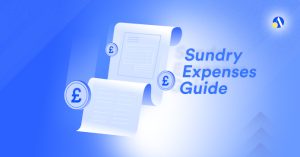A Guide for UK Businesses
Every business has expenses, that's a given. But do you know which ones are direct costs and which are essential for simply keeping the lights on? While some expenses are tied directly to what you sell (think product materials), others are the quiet, constant costs that ensure your operations run smoothly. These are your overhead costs.
Understanding these vital expenses is more than just an accounting chore. It's a cornerstone of sound financial management, enabling you to set accurate prices, forecast profitability, and make informed business decisions. Are you ready to get a clear handle on your business's financial pulse? This guide will break down everything you need to know about overheads, from their calculation to their impact on your tax situation.
What Are Overhead Costs in Accounting?
Overhead costs are the ongoing expenses required to run a business that aren’t directly tied to producing goods or services. Think of them as the essential costs that keep your business operational, regardless of whether you're making sales.
For example, imagine you run a bakery. The flour you use to bake bread is a direct cost—it’s directly linked to the product you sell. But what about the rent for your shop or the electricity that powers your ovens? Those are overheads. You have to pay them whether you sell one loaf or a thousand.
Why does this matter? Because overheads appear on your profit and loss statement and directly impact your business's financial health. Keeping them in check is crucial for long-term success.
Examples of Overhead Costs
What does an overhead look like for your business? It’s not a one-size-fits-all concept. While an online marketing consultant might have minimal overheads, a manufacturing company's costs will be significantly higher.
To give you a clearer understanding, here are some common overhead costs that many businesses face:
- Rent: The cost of your office, shop, or any other physical premises.
- Utility Bills: Essentials like gas, electricity, and water keep your operations running.
- Business Insurance: A vital safeguard against unforeseen events.
- Administrative Staff Salaries: Pay for employees who aren't directly involved in producing your goods or services but keep the business moving.
- Accounting and Legal Fees: Professional services crucial for compliance and guidance.
- Website Hosting and Software Subscriptions: The digital tools that power your business.
- Office Supplies: Everyday items, from pens to printer ink, that support daily work.
What Are the Types of Overhead?
Overhead costs can be grouped into three main categories. Understanding these distinctions helps with budgeting and financial forecasting.
Fixed Overheads
As the name implies, these costs stay consistent each month. They don't change with the level of business activity. This predictability makes them easier to budget for.
- Examples: Rent, business insurance premiums, and salaries for your administrative team.
Variable Overheads
These costs fluctuate depending on your business activity. When your business is busier, these costs tend to rise.
- Examples: Office supplies, marketing campaign spending, or shipping costs for non-product-related items. A restaurant's water bill might also be considered a variable overhead, as it changes with the number of customers served.
Semi-variable Overheads
These are a hybrid of fixed and variable costs. They typically have a base fixed rate, with an additional cost that varies with usage.
- Examples: A business phone contract is a great example. You pay a fixed monthly line rental, but you might incur extra charges if you go over your data or call allowance. Some utility bills can also fall into this category, with a fixed standing charge and a variable usage charge.
How Do You Calculate Overhead Cost?
Ready to get a clear picture of your business's true running costs? Understanding how to calculate your overheads is a powerful step towards smarter financial management.
First things first: you need to sum up all those indirect business expenses we've been talking about for a specific period – think monthly, quarterly, or annually. This includes all your fixed, variable, and semi-variable costs.
Here’s the simple sum:
| Total Overhead Costs | Overhead Rate |
| Sum of all Indirect Costs (Fixed + Variable + Semi-variable) | Total Indirect Costs / Allocation Measure |
| This formula helps you tally up all your indirect expenses for a specific period. | This formula reveals how much it costs to run your business in relation to another key factor. |
Once you've calculated your Total Overhead Costs, you can use that figure to determine your overhead rate. What does the overhead rate tell you? It helps you understand the proportion of overheads compared to a specific benchmark, such as your direct labour costs or total sales revenue. This insight is incredibly valuable for making informed business decisions!
Your "allocation measure" is the specific point of comparison you choose for your overheads. Common examples include:
- Total direct labour costs
- Machine hours
- Total sales revenue
Let's look at an example to make it crystal clear:
Imagine your total overheads for the month were £10,000, and your direct labour costs for the same period were £5,000.
`Overhead Rate = £10,000 (Total Overheads) / £5,000 (Direct Labour Costs) = 2`
What does an overhead rate of '2' mean in this scenario? It indicates that for every £1 you spend on direct labour, you're spending an additional £2 on overheads. Powerful stuff, right? This kind of precision helps you pinpoint where your money is really going.
What Does 30% Overhead Mean?
If someone says their business has a 30% overhead, it usually means that 30% of their total revenue is spent on overhead costs. For example, if your monthly revenue is £100,000, a 30% overhead means you spend £30,000 on indirect costs.
How Do Overheads Affect Your Tax Bill?
Here's some good news: many overhead costs are considered allowable expenses by HMRC. This means you can deduct them from your business's income before calculating your tax bill. By claiming these expenses, you reduce your taxable profit and, therefore, the amount of tax you need to pay.
It's crucial to keep accurate records of all your overhead expenses, including receipts and invoices, to ensure you can claim everything you're entitled to.
Master Your Business Finances
Understanding and managing your overheads isn’t just good practice—it's essential for your business's survival and growth. By diligently tracking these expenses, you can make informed decisions that directly impact your profitability, from cutting unnecessary costs to pricing your products and services correctly. Don't let hidden expenses eat away at your profits.
Feeling overwhelmed by spreadsheets and receipts? You don't have to manage it all alone. Debitam offers intuitive accounting solutions designed to simplify your financial management. We help you track overheads, prepare for tax returns, and gain the clarity you need to run your business with confidence.
Ready to take control of your finances? Have a chat with Debitam today and see how simple mastering your business finances can be.













